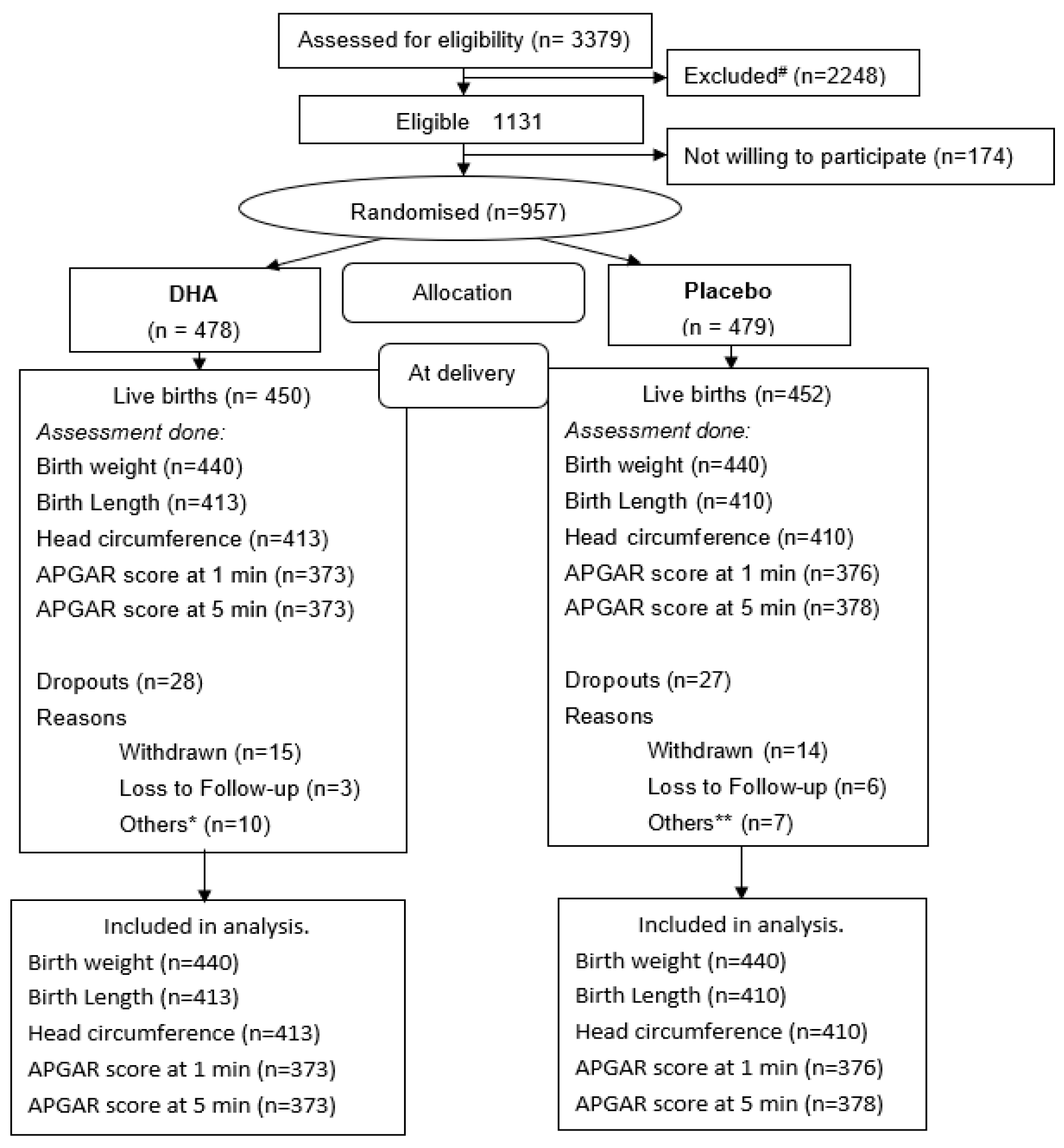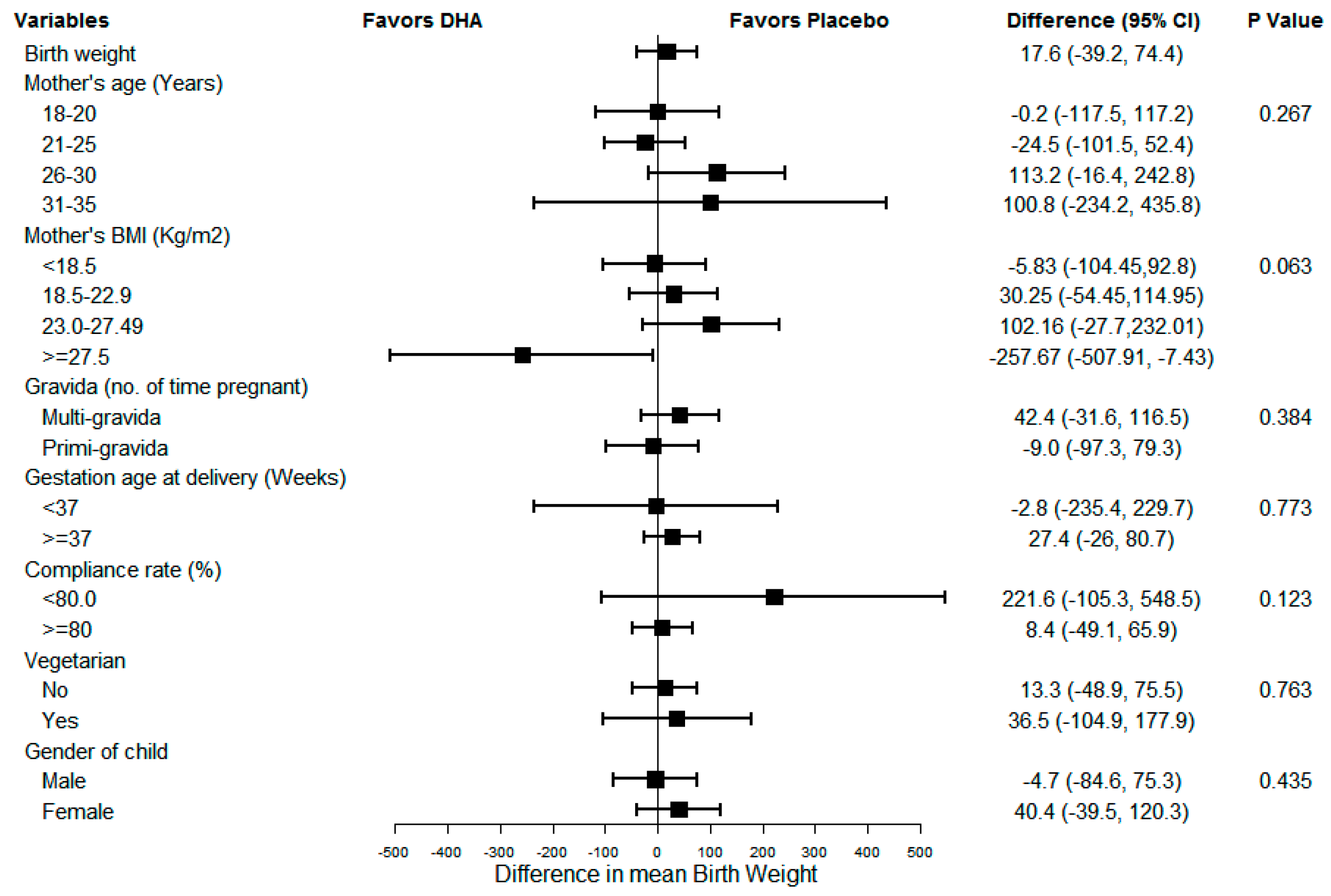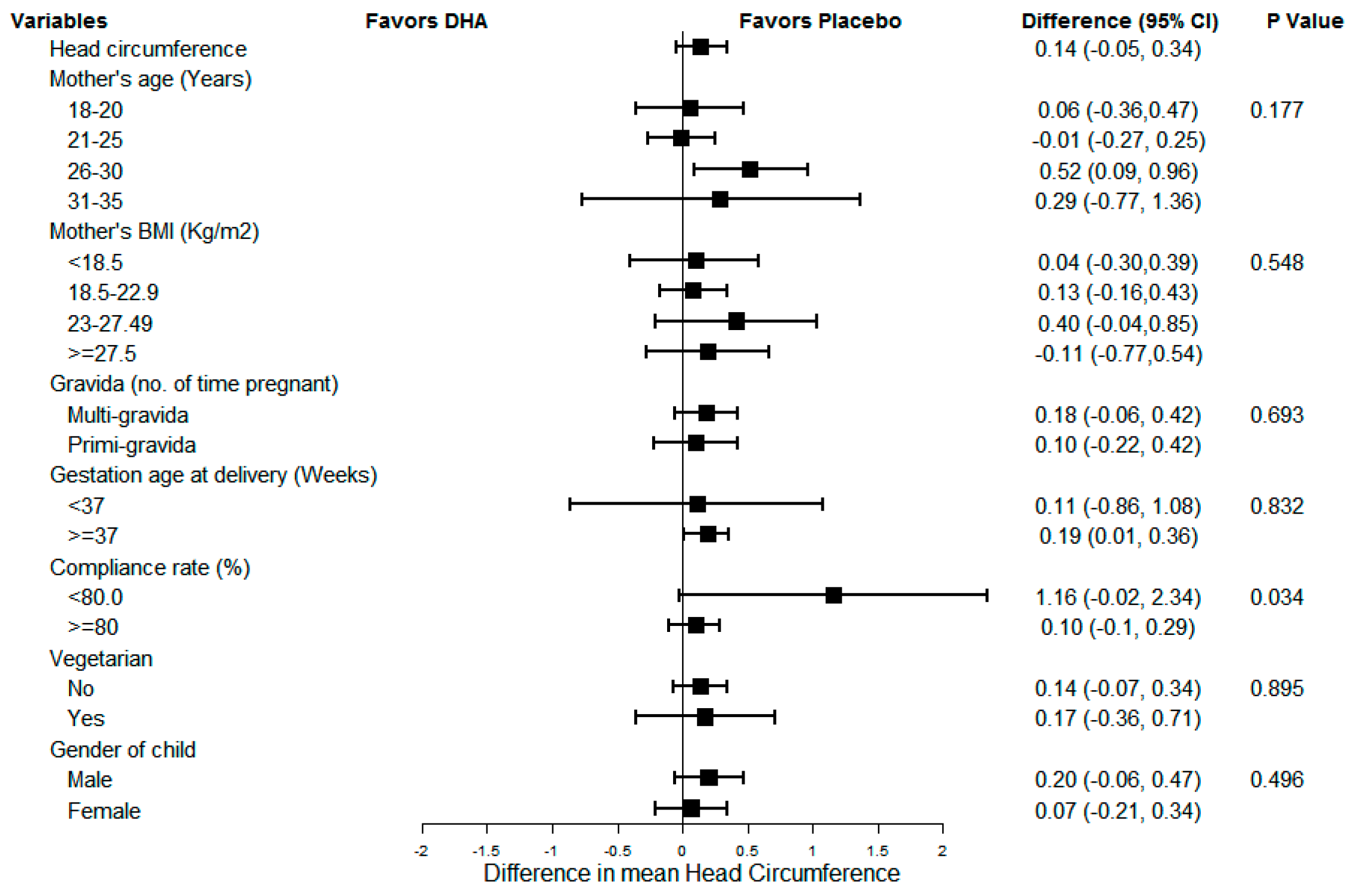Prenatal Maternal Docosahexaenoic Acid (DHA) Supplementation and Newborn Anthropometry in India: Findings from DHANI
Abstract
1. Introduction
2. Materials and Methods
2.1. Trial Design and Setting
2.2. Participants and Trial Procedures
2.3. Randomization, Masking, and Intervention
2.4. Outcomes
2.5. Adherence and Follow Up
2.6. Statistical Analysis
3. Results
3.1. Trial Population
3.2. Outcomes
3.3. Sub-Group Analysis
4. Discussion
5. Conclusions
Supplementary Materials
Author Contributions
Funding
Institutional Review Board Statement
Informed Consent Statement
Data Availability Statement
Acknowledgments
Conflicts of Interest
References
- Law, C.M. Significance of birth weight for the future. Arch. Dis. Child. -Fetal Neonatal Ed. 2002, 86, F7. [Google Scholar] [CrossRef]
- Blencowe, H.; Krasevec, J.; De Onis, M.; Black, R.E.; An, X.; Stevens, G.A.; Borghi, E.; Hayashi, C.; Estevez, D.; Cegolon, L.; et al. National, regional, and worldwide estimates of low birthweight in 2015, with trends from 2000: A systematic analysis. Lancet Glob. Health 2019, 7, e849–e860. [Google Scholar] [CrossRef]
- Lee, A.C.C.; Katz, J.; Blencowe, H.; Cousens, S.; Kozuki, N.; Vogel, J.P.; Adair, L.; Baqui, A.H.; Bhutta, Z.A.; Caulfield, L.E.; et al. National and regional estimates of term and preterm babies born small for gestational age in 138 low-income and middle-income countries in 2010. Lancet Glob. Health 2013, 1, e26–e36. [Google Scholar] [CrossRef]
- Nordman, H.; Jääskeläinen, J.; Voutilainen, R. Birth Size as a Determinant of Cardiometabolic Risk Factors in Children. Horm. Res. Paediatr. 2020, 93, 144–153. [Google Scholar] [CrossRef]
- Groer, M.W.; Gregory, K.E.; Louis-Jacques, A.; Thibeau, S.; Walker, W.A. The very low birth weight infant microbiome and childhood health. Birth Defects Res. Part C Embryo Today Rev. 2015, 105, 252–264. [Google Scholar] [CrossRef]
- Kanda, T.; Murai-Takeda, A.; Kawabe, H.; Itoh, H. Low birth weight trends: Possible impacts on the prevalences of hypertension and chronic kidney disease. Hypertens. Res. 2020, 43, 859–868. [Google Scholar] [CrossRef] [PubMed]
- Brown, H.L.; Smith, G.N. Pregnancy Complications, Cardiovascular Risk Factors, and Future Heart Disease. Obstet. Gynecol. Clin. N. Am. 2020, 47, 487–495. [Google Scholar] [CrossRef]
- Yajnik, C.S.; Deshmukh, U.S. Maternal nutrition, intrauterine programming and consequential risks in the offspring. Rev. Endocr. Metab. Disord. 2008, 9, 203–211. [Google Scholar] [CrossRef]
- Stein, A.D.; Barros, F.C.; Bhargava, S.K.; Hao, W.; Horta, B.L.; Lee, N.; Kuzawa, C.W.; Martorell, R.; Ramji, S.; Stein, A.; et al. Birth Status, Child Growth, and Adult Outcomes in Low- and Middle-Income Countries. J. Pediatr. 2013, 163, 1740–1746.e4. [Google Scholar] [CrossRef]
- Cutland, C.L.; Lackritz, E.M.; Mallett-Moore, T.; Bardají, A.; Chandrasekaran, R.; Lahariya, C.; Nisar, M.I.; Tapia, M.D.; Pathirana, J.; Kochhar, S.; et al. Low birth weight: Case definition & guidelines for data collection, analysis, and presentation of maternal immunization safety data. Vaccine 2017, 35, 6492–6500. [Google Scholar] [CrossRef]
- Kader, M.; Perera, N.K.P.P. Socio-economic and nutritional determinants of low birth weight in India. N. Am. J. Med Sci. 2014, 6, 302–308. [Google Scholar] [CrossRef]
- Das, J.K.; Hoodbhoy, Z.; Salam, R.A.; Bhutta, A.Z.; Valenzuela-Rubio, N.G.; Prinzo, Z.W.; Bhutta, Z.A. Lipid-based nutrient supplements for maternal, birth, and infant developmental outcomes. Cochrane Database Syst. Rev. 2018, 8, CD012610. [Google Scholar] [CrossRef]
- Velzing-Aarts, F.; Van Der Klis, F.; Van Der Dijs, F.; Van Beusekom, C.; Landman, H.; Capello, J.; Muskiet, F. Effect of three low-dose fish oil supplements, administered during pregnancy, on neonatal long-chain polyunsaturated fatty acid status at birth. Prostaglandins Leukot. Essent. Fat. Acids 2001, 65, 51–57. [Google Scholar] [CrossRef]
- Carlson, E.S. Docosahexaenoic acid supplementation in pregnancy and lactation. Am. J. Clin. Nutr. 2008, 89, 678S–684S. [Google Scholar] [CrossRef]
- Tupe, R.; Chiplonkar, S.A. Diet patterns of lactovegetarian adolescent girls: Need for devising recipes with high zinc bioavailability. Nutrition 2010, 26, 390–398. [Google Scholar] [CrossRef] [PubMed]
- Dwarkanath, P.; Muthayya, S.; Thomas, T.; Vaz, M.; Parikh, P.; Mehra, R.; Kurpad, A.V. Polyunsaturated fatty acid consumption and concentration among South Indian women during pregnancy. Asia Pac. J. Clin. Nutr. 2009, 18, 389–394. [Google Scholar] [PubMed]
- Food and Agriculture Organization (FAO). Fats and Fatty Acids in Human Nutrition: Report of an Expert Consultation; FAO: Rome, Italy, 2010; FAO Food and Nutrition Paper 91. [Google Scholar]
- Muthayya, S.; Dwarkanath, P.; Thomas, T.; Ramprakash, S.; Mehra, R.; Mhaskar, A.; Mhaskar, R.; Thomas, A.; Bhat, S.; Vaz, M.; et al. The effect of fish and omega-3 LCPUFA intake on low birth weight in Indian pregnant women. Eur. J. Clin. Nutr. 2009, 63, 340–346. [Google Scholar] [CrossRef]
- Makrides, M.; Best, K. Docosahexaenoic Acid and Preterm Birth. Ann. Nutr. Metab. 2016, 69, 29–34. [Google Scholar] [CrossRef]
- Carlson, E.S.; Colombo, J.; Gajewski, B.J.; Gustafson, K.M.; Mundy, D.; Yeast, J.; Georgieff, M.K.; Markley, L.A.; Kerling, E.H.; Shaddy, D.J. DHA supplementation and pregnancy outcomes. Am. J. Clin. Nutr. 2013, 97, 808–815. [Google Scholar] [CrossRef]
- Ramakrishnan, U.; Stein, A.D.; Parra-Cabrera, S.; Wang, M.; Imhoff-Kunsch, B.; Juárez-Márquez, S.; Rivera, J.; Martorell, R. Effects of Docosahexaenoic Acid Supplementation During Pregnancy on Gestational Age and Size at Birth: Randomized, Double-Blind, Placebo-Controlled Trial in Mexico. Food Nutr. Bull. 2010, 31, S108–S116. [Google Scholar] [CrossRef]
- Makrides, M.; Gibson, R.A.; McPhee, A.J.; Yell, L.; Quinlivan, J.; Ryan, P. Effect of DHA Supplementation During Pregnancy on Maternal Depression and Neurodevelopment of Young Children: A Randomized Controlled Trial. Obstet. Gynecol. Surv. 2011, 66, 79–81. [Google Scholar] [CrossRef]
- Khandelwal, S.; Kondal, D.; Chaudhry, M.; Patil, K.; Swamy, M.K.; Metgud, D.; Jogalekar, S.; Kamate, M.; Divan, G.; Gupta, R.; et al. Effect of Maternal Docosahexaenoic Acid (DHA) Supplementation on Offspring Neurodevelopment at 12 Months in India: A Randomized Controlled Trial. Nutrients 2020, 12, 3041. [Google Scholar] [CrossRef]
- Villar, J.; Ismail, L.C.; Victora, C.G.; Ohuma, E.O.; Bertino, E.; Altman, D.G.; Lambert, A.; Papageorghiou, A.T.; Carvalho, M.; Jaffer, Y.A.; et al. International standards for newborn weight, length, and head circumference by gestational age and sex: The Newborn Cross-Sectional Study of the INTERGROWTH-21st Project. Lancet 2014, 384, 857–868. [Google Scholar] [CrossRef]
- Wold Health Organization. WHO expert consultation, Appropriate body-mass index for Asian populations and its implications for policy and intervention strategies. Lancet 2004, 363, 157–163. [Google Scholar] [CrossRef]
- Harris, M.A.; Reece, M.S.; McGregor, J.A.; Wilson, J.W.; Burke, S.M.; Wheeler, M.; Anderson, J.E.; Auld, G.W.; French, J.I.; Allen, K.G.D. The Effect of Omega-3 Docosahexaenoic Acid Supplementation on Gestational Length: Randomized Trial of Supplementation Compared to Nutrition Education for Increasing n-3 Intake from Foods. BioMed Res. Int. 2015, 2015, 123078. [Google Scholar] [CrossRef]
- Calder, P.C. Docosahexaenoic Acid. Ann. Nutr. Metab. 2016, 69 (Suppl. 1), 7–21. [Google Scholar] [CrossRef]
- Allen, K.G.; Harris, M.A. The Role of n-3 Fatty Acids in Gestation and Parturition. Exp. Biol. Med. 2001, 226, 498–506. [Google Scholar] [CrossRef] [PubMed]
- Middleton, P.; Gomersall, J.C.; Gould, J.F.; Shepherd, E.; Olsen, S.F.; Makrides, M. Omega-3 fatty acid addition during pregnancy. Cochrane Database Syst. Rev. 2018, 11, CD003402. [Google Scholar] [CrossRef]
- Stein, A.D.; Wang, M.; Martorell, R.; Neufeld, L.M.; Flores-Ayala, R.; Rivera, J.A.; Ramakrishnan, U. Growth to Age 18 Months Following Prenatal Supplementation with Docosahexaenoic Acid Differs by Maternal Gravidity in Mexico. J. Nutr. 2010, 141, 316–320. [Google Scholar] [CrossRef]
- Varma, J.R.; Nimbalkar, S.M.; Patel, D.; Phatak, A.G. The Level and Sources of Stress in Mothers of Infants Admitted in Neonatal Intensive Care Unit. Indian J. Psychol. Med. 2019, 41, 338–342. [Google Scholar] [CrossRef]
- Mousa, A.; Naqash, A.; Lim, S. Macronutrient and Micronutrient Intake during Pregnancy: An Overview of Recent Evidence. Nutrients 2019, 11, 443. [Google Scholar] [CrossRef]
- Gonzalez-Casanova, I.; Rzehak, P.; Stein, A.D.; Feregrino, R.G.; Dommarco, J.A.R.; Barraza-Villarreal, A.; Demmelmair, H.; Romieu, I.; Villalpando, S.; Martorell, R.; et al. Maternal single nucleotide polymorphisms in the fatty acid desaturase 1 and 2 coding regions modify the impact of prenatal supplementation with DHA on birth weight. Am. J. Clin. Nutr. 2016, 103, 1171–1178. [Google Scholar] [CrossRef] [PubMed]
- Scholtz, S.; Kerling, E.; Shaddy, D.; Li, S.; Thodosoff, J.; Colombo, J.; Carlson, S. Docosahexaenoic acid (DHA) supplementation in pregnancy differentially modulates arachidonic acid and DHA status across FADS genotypes in pregnancy. Prostaglandins Leukot. Essent. Fat. Acids 2015, 94, 29–33. [Google Scholar] [CrossRef]




| Variable | DHA (n = 478) | Placebo (n = 479) |
|---|---|---|
| Maternal age (year), mean ± SD | 23.5 ± 3.5 | 23.6 ± 3.7 |
| Gestational age at enrollment (weeks), median (p25, p75) | 15.0 (12.0, 18.0) | 14.0 (12.0, 18.0) |
| Weight (kg), mean ± SD | 48.9 ± 9.0 | 48.9 ± 8.5 |
| Height (cm), mean ± SD | 154.1 ± 5.6 | 153.9 ± 5.7 |
| Body mass index (kg/m2), mean ± SD | 20.5 ± 3.5 | 20.7 ± 3.6 |
| MUAC (cm), mean ± SD | 24.3 ± 3.0 | 24.3 ± 3.1 |
| Hb (g%), mean ± SD | 11.1 ± 1.3 | 11.2 ± 1.3 |
| DHA (mol% of fatty acid) *, mean ± SD | 0.86 ± 0.78 | 0.88 ± 0.71 |
| DHA Levels | DHA | Placebo | Mean Difference * (95% CI) | p-Value |
|---|---|---|---|---|
| n, Mean ± SD, Median (p25, p75) | n, Mean ± SD, Median (p25, p75) | |||
| Overall | ||||
| DHA at baseline | n = 256, 0.86 ± 0.78, 0.56 (0.31, 1.20) | n = 224, 0.88 ± 0.71, 0.55 (0.37, 1.28) | 0.02 (−0.11, 0.15) | 0.770 |
| DHA at delivery | n = 269, 2.03 ± 1.76, 1.41 (0.61, 2.99) | n = 242, 1.12 ± 0.86, 0.83 (0.42, 1.72) | −0.91 (−1.16, −0.67) | <0.001 |
| Birth Weight < 2500 g | ||||
| DHA at baseline | n = 63, 0.96 ± 0.89, 0.59 (0.39, 1.41) | n = 47, 0.74 ± 0.69, 0.46 (0.37, 0.95) | −0.22 (−0.53, 0.09) | 0.170 |
| DHA at delivery | n = 67, 2.00 ± 1.81, 1.39 (0.63, 2.79) | n = 50, 1.17 ± 0.80, 0.96 (0.48, 1.74) | −0.83 (−1.37, −0.29) | 0.003 |
| Birth Weight ≥ 2500 g | ||||
| DHA at baseline | n = 193, 0.83 ± 0.75, 0.53 (0.3, 1.11) | n = 177, 0.92 ± 0.71, 0.59 (0.37, 1.33) | 0.09 (−0.06, 0.24) | 0.221 |
| DHA at delivery | n = 202, 2.04 ± 1.74, 1.43 (0.6, 3.17) | n = 192, 1.10± 0.88, 0.78 (0.4, 1.7) | −0.94 (−1.22, −0.66) | <0.001 |
| Gestation Age < 37 Weeks | ||||
| DHA at baseline | n = 18, 1.1 ± 0.74, 0.79 (0.61, 1.55) | n = 19, 0.55 ± 0.37, 0.41 (0.37, 0.66) | −0.55 (−0.93, −0.16) | 0.007 |
| DHA at delivery | n = 17, 2.24 ± 1.81, 1.72 (0.96, 2.97) | n = 19, 0.99 ± 0.72, 0.62 (0.41, 1.72) | 1.25 (−2.16, −0.33) | 0.009 |
| Gestation Age ≥ 37 Weeks | ||||
| DHA at baseline | n = 238,0.84 ± 0.79, 0.53 (0.31, 1.14) | n = 205,0.91 ± 0.72, 0.59 (0.37, 1.3) | −0.07 (−0.07, 0.21) | 0.333 |
| DHA at delivery | n = 252, 2.02 ± 1.76, 1.4 (0.59, 3.08) | n = 223, 1.13 ± 0.87, 0.83 (0.42, 1.72) | −0.89 (−1.15, −0.64) | <0.001 |
| Birth Length < 50 cm | ||||
| DHA at baseline | n = 234, 0.89 ± 0.81, 0.58 (0.32, 1.33) | n = 194, 0.85 ± 0.71, 0.52 (0.34, 1.23) | −0.04 (0.1, −0.33) | 0.556 |
| DHA at delivery | n = 245, 2.04 ± 1.77, 1.39 (0.62, 3.17) | n = 213, 1.1 ± 0.86, 0.78 (0.42, 1.72) | −0.94 (-0.68, −0.33) | <0.0001 |
| Birth Length ≥ 50 cm | ||||
| DHA at baseline | n = 21, 0.51 ± 0.33, 0.44 (0.28, 0.59) | n = 30, 1.11 ± 0.64, 1 (0.62, 1.47) | 0.6 (0.91, −0.33) | 0.0003 |
| DHA at delivery | n = 24, 1.97 ± 1.7, 1.72 (0.58, 2.45) | n = 29, 1.28 ± 0.87, 1.14 (0.54, 1.73) | −0.69 (0.04, −0.33) | 0.063 |
| Head Circumference < 34 cm | ||||
| DHA at baseline | N = 123, 0.95 ± 0.89, 0.59 (0.34, 1.36) | N = 98, 0.82 ± 0.66, 0.53 (0.39, 1.23) | −0.12 (0.09, −0.33) | 0.258 |
| DHA at delivery | n=132, 2.16 ± 1.81, 1.49 (0.73, 2.98) | N = 106, 1.16 ± 0.89, 0.93 (0.45, 1.74) | −1.00 (−0.62, −0.33) | <0.0001 |
| Head Circumference ≥ 34 cm | ||||
| DHA at baseline | n = 132, 0.78 ± 0.67, 0.52 (0.29, 0.97) | n = 126, 0.93 ± 0.74, 0.57 (0.34, 1.4) | 0.15 (0.32, −0.33) | 0.0916 |
| DHA at delivery | n = 137,1.91 ± 1.7, 1.19 (0.55, 3.17) | n = 136, 1.08 ± 0.84, 0.78 (0.41, 1.7) | −0.83 (−0.51, −0.33) | <0.0001 |
| Birth Outcomes | DHA | Placebo | Mean Difference § (95% CI) | p-Value | ||
|---|---|---|---|---|---|---|
| n | Mean ± SD/n (%) | n | Mean ± SD/n (%) | |||
| Gestational age at delivery (weeks) | 440 | 38.8 ± 1.7 | 440 | 38.8 ± 1.7 | 0.07 (−0.16, 0.30) | 0.54 |
| Preterm birth (gestation < 37 week) † | 440 | 28 (6.4%) | 440 | 33 (7.5%) | 0.01 (−0.02, 0.04)‡ | 0.52 |
| Newborn Anthropometry | ||||||
| Birth weight (grams) | 440 | 2750.6 ± 421.5 | 440 | 2768.2 ± 436.6 | 17.6 (−39.2, 74.4) | 0.54 |
| Low birth weight (<2500 g) † | 440 | 105 (23.9%) | 440 | 99 (22.5%) | −0.01 (−0.07, 0.04) ‡ | 0.63 |
| Birth length (cm) | 413 | 47.3 ± 2.0 | 410 | 47.5 ± 2.0 | 0.21 (−0.06, 0.48) | 0.13 |
| Birth head circumference (cm) | 413 | 33.7 ± 1.4 | 410 | 33.8 ± 1.4 | 0.14 (−0.05, 0.34) | 0.15 |
| Apgar score at 1 min | 372 | 6.9 ± 0.8 | 376 | 6.9 ± 0.8 | 0.01 (−0.11, 0.13) | 0.91 |
| Apgar score at 5 min | 373 | 8.0 ± 0.7 | 378 | 8.0 ± 0.7 | 0.03 (−0.07, 0.12) | 0.60 |
| Size for Gestational Age and Sex According to Standardized Measures ¶ | ||||||
| Birth weight for gestational age z score | 440 | −0.97 ± 0.98 | 440 | −0.95 ± 0.95 | 0.03 (−0.1, 0.16) | 0.67 |
| Birth length for gestational age z score | 413 | −0.84 ± 1.04 | 410 | −0.73 ± 1.12 | 0.11 (−0.03, 0.26) | 0.13 |
| Birth head circumference for gestational age z score. | 413 | 0.09 ± 1.05 | 410 | 0.20 ± 0.97 | 0.11 (−0.03, 0.25) | 0.11 |
| Small for gestational age *,@ | 440 | 172 (39.1%) | 440 | 172 (39.1%) | na | na |
Publisher’s Note: MDPI stays neutral with regard to jurisdictional claims in published maps and institutional affiliations. |
© 2021 by the authors. Licensee MDPI, Basel, Switzerland. This article is an open access article distributed under the terms and conditions of the Creative Commons Attribution (CC BY) license (http://creativecommons.org/licenses/by/4.0/).
Share and Cite
Khandelwal, S.; Kondal, D.; Chaudhry, M.; Patil, K.; Swamy, M.K.; Pujeri, G.; Mane, S.B.; Kudachi, Y.; Gupta, R.; Ramakrishnan, U.; et al. Prenatal Maternal Docosahexaenoic Acid (DHA) Supplementation and Newborn Anthropometry in India: Findings from DHANI. Nutrients 2021, 13, 730. https://doi.org/10.3390/nu13030730
Khandelwal S, Kondal D, Chaudhry M, Patil K, Swamy MK, Pujeri G, Mane SB, Kudachi Y, Gupta R, Ramakrishnan U, et al. Prenatal Maternal Docosahexaenoic Acid (DHA) Supplementation and Newborn Anthropometry in India: Findings from DHANI. Nutrients. 2021; 13(3):730. https://doi.org/10.3390/nu13030730
Chicago/Turabian StyleKhandelwal, Shweta, Dimple Kondal, Monica Chaudhry, Kamal Patil, Mallaiah Kenchaveeraiah Swamy, Gangubai Pujeri, Swati Babu Mane, Yashaswi Kudachi, Ruby Gupta, Usha Ramakrishnan, and et al. 2021. "Prenatal Maternal Docosahexaenoic Acid (DHA) Supplementation and Newborn Anthropometry in India: Findings from DHANI" Nutrients 13, no. 3: 730. https://doi.org/10.3390/nu13030730
APA StyleKhandelwal, S., Kondal, D., Chaudhry, M., Patil, K., Swamy, M. K., Pujeri, G., Mane, S. B., Kudachi, Y., Gupta, R., Ramakrishnan, U., Stein, A. D., Prabhakaran, D., & Tandon, N. (2021). Prenatal Maternal Docosahexaenoic Acid (DHA) Supplementation and Newborn Anthropometry in India: Findings from DHANI. Nutrients, 13(3), 730. https://doi.org/10.3390/nu13030730







